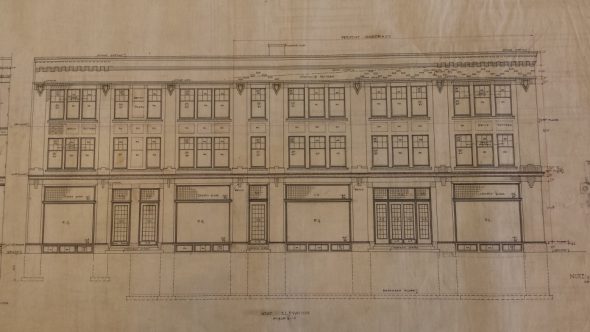Weise Building Gets Temporary Historic Designation
Developers may save facades of century-old Eschweiler-designed building on Farwell.
The city Historic Preservation Commission (HPC) voted unanimously Tuesday to grant a temporary historic designation to the Paul Weise Furniture Building at the corner of N. Farwell Avenue and E. Albion Street.
But that doesn’t mean the site won’t be developed in coming years. The building owner and his development partner are interested in maintaining some of the building’s facades, and constructing a residential development that is set back from the street facing perimeter walls. This suggestion went over well with HPC members and the neighborhood’s alderman Nik Kovac.
Still, the historic designation enjoys support from Kovac, the HPC staff, the Milwaukee Preservation Alliance and members of the surrounding community.
The building itself is a three-story commercial brick-building originally constructed during three separate builds between 1903 and 1922. According to the historic preservation study report, at the time it was built, “The commercial style building would have been considered modern.” For its entire history, it has housed Paul Weise Furniture.
The original Paul Weise came to Milwaukee from Germany in 1882. He started selling furniture to wealthy east side residents on his own in 1886. The resulting business has been in operation for more than 130 years.
Alexander Eschweiler designed the building. He was a prominent Milwaukee architect in the late 19th and early 20th century and designed such notable Milwaukee buildings as the Wisconsin Gas Building on Wisconsin Avenue and the Charles Allis home.
Paul Carl Weise Jr., former owner and heir to the Weise building, said his family told him Eschweiler was a family friend and customer. The building, located near the Prospect Ave. mansion district, catered to high end clientele.
“The customer base has always been the Eschweiler people of Milwaukee,” he said.
Weise has partnered with the current owner of the building, Steve Stein, in the potential redevelopment. Neither expressed a wish to raze the structure, but Stein intimated the business is no longer viable, at least not in that location. And Weise, a commercial real estate developer, said the area is ripe for a residential development.
“Retail has changed,” Stein said. “The way customers and people shop today, as you all know, has changed.”
On Tuesday, the HPC was tasked with determining if the building met historic preservation standards. Stein applied for state historic preservation, but was denied historic status and historic tax credits for the building.
Kovac said he was “discouraged” when the Wisconsin Historical Society denied this, and said, “We’ve been getting some discouraging news from them lately, in general, on a number of different projects.”
Weise told the commission he wouldn’t fight the local historic designation. As a member of the Weise family, the building naturally is important to him. But when the state denied the designation, he and Stein pursued a demolition permit in hopes of redeveloping the location.
“We applied for demolition permits so that we can do whatever we want with the east wall and the north wall,” Weise said.
Those two facades are the only Eschweiler facades still on the building, he said. Even the guts of the structure don’t always follow closely what the architect drew up more than 100 years ago, Weise added.
Weise and Stein said any objections they have are not with the prospect of historic designation, but with historic preservation guidelines they feel are too stringent for them to maintain the building. “I’m not gonna fight Carlen and City Hall, that’s for sure,” Weise said, referring to Carlen Hatala, the city’s senior planner with the HPC.
He and Stein proffered the idea Tuesday that they would keep the two Eschweiler facades and build a residential unit, setback and above the structure, and in good taste for the neighborhood.
“I don’t want to tear down an Eschweiler structure,” Weise said. “It’s just the guidelines.”
Kovac said he would be open to a project that maintained the Eschweiler facades, but said he wants to work with the developers on what they have in mind, and will reserve his judgment until plans are produced.
Alderman and HPC member Bob Bauman said he’s displeased with renovations of historic buildings that haven’t preserved the original character, but said, “If there’s a willingness to preserve the facade, I think we can do business.”
If you think stories like this are important, become a member of Urban Milwaukee and help support real, independent journalism. Plus you get some cool added benefits.























I can’t say I really understand the fascination with preserving this building beyond the fact that it’s old. Other than the canopy over the main entrance, it seems like an anonymous brick building that isn’t really visually unique from other brick buildings on the Eastside.
A contemporary building would be a vast improvement.
The block to the south is also a trrrible eyesore. Perhaps that block can get redeveloped as well.
We live a block away, and have not been notified of anything for the site. Nor, have we ever been notified of any building considerations in the area. When has alderman Novac said no?